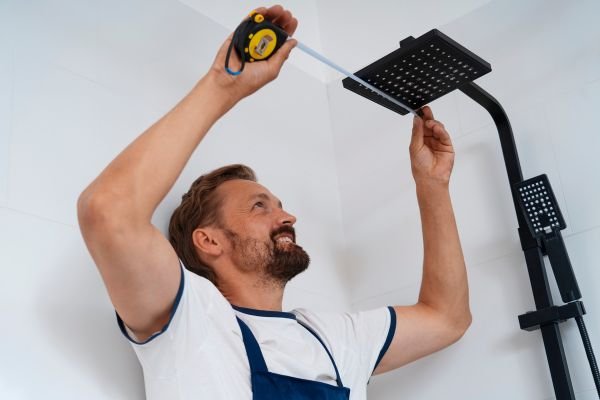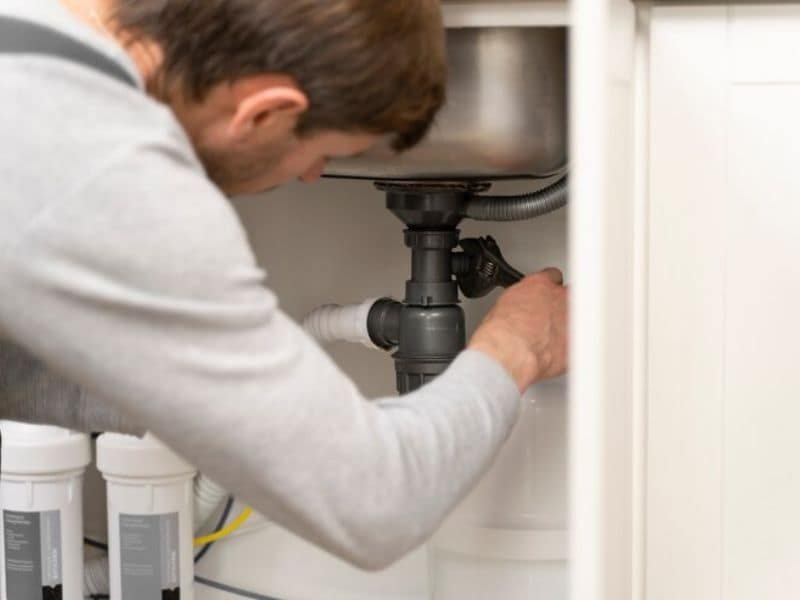Some things are as disappointing as it is to step into the shower with a weak move of water instead of just a refreshing stream. Low water pressure in your shower can turn a comfortable experience to daily annoyance. Fortunately, the problem is often cured with some simple steps.
In this guide, we’ll explore the common causes of low shower water pressure and give you practical solutions to restore strong water flow.

What Causes Low Water Pressure in Showers?
Low water pressure in showers can stem from several issues. Some are quick fixes, while others may require professional plumbing work. Common causes include:
- Low-Flow Showerhead Restrictions: Many modern showerheads are designed with built-in flow restrictors to conserve water, limiting output to 2.5 gallons per minute (GPM) or less. Over time, these can become overly restrictive or clogged.
- Clogged Showerhead: Mineral deposits (limescale), sediment, or debris can build up in the showerhead’s nozzles or screen, blocking water flow.
- Faulty Mixing Valve or Diverter: In shower-tub combos, a worn-out diverter valve (which switches water from tub to shower) can restrict flow. Similarly, the mixing valve that blends hot and cold water may fail due to age or debris.
- Clogged Pipes or Aerators: Corrosion, sediment, or mineral buildup in pipes or faucet aerators can reduce pressure system-wide.
- Water Pressure Regulator Issues: A faulty home pressure regulator or high municipal water pressure can cause imbalances.
- Other Systemic Problems: Leaks, old galvanized pipes, or issues with the water heater can indirectly affect shower pressure.
If the low pressure is isolated to the shower (while other fixtures are fine), the issue is likely local to the showerhead or valves. If it’s house-wide, broader plumbing problems may be at play.
Tools and Materials Needed
- Bucket or basin
- Adjustable wrench or pliers
- White vinegar (for descaling)
- Toothbrush or small brush
- Pipe tape (Teflon tape)
- Replacement showerhead (optional)
- Hairdryer or heat gun (for thawing frozen pipes, if applicable)
- Pressure gauge (optional, for testing home water pressure)
Safety Precautions
- Turn off the water supply at the shut-off valve before disassembling fixtures to avoid floods.
- Wear gloves to protect against sharp edges or hot water.
- If dealing with electrical components (e.g., near a water heater), ensure power is off.
- For gas water heaters or complex valve replacements, consult a professional to avoid hazards.
READ MORE: How Long Does Copper Plumbing Last?
Step-by-Step Guide to Fixing Low Water Pressure
Start with the simplest fixes and progress to more involved solutions. Test the pressure after each step.
1. Clean or Remove the Showerhead Restrictor
Many showerheads have a small plastic disc or screen that limits flow for efficiency.
- Steps:
- Unscrew the showerhead from the arm using a wrench (wrap the arm with cloth to prevent scratches).
- Locate the flow restrictor (often a green or white plastic piece inside the showerhead stem).
- Gently remove it with pliers or a screwdriver.
- Reassemble and test the flow.
- Expected Result: Increased pressure without wasting excessive water. If the restrictor is clogged, soak the showerhead in vinegar overnight to dissolve buildup.
2. Descale the Showerhead
Mineral deposits are a top cause of reduced flow.
- Steps:
- Remove the showerhead as above.
- Soak it in a bowl of white vinegar for 30 minutes to several hours (or overnight for heavy buildup).
- Scrub nozzles with a toothbrush to remove loosened scale.
- Rinse thoroughly and reinstall.
- Tip: For stubborn clogs, poke holes with a needle or drill them slightly larger (use caution to avoid damage).
3. Check and Clean the Diverter Valve (for Shower-Tub Combos)
If pressure is fine from the tub spout but low in the shower, the diverter is likely faulty.
- Steps:
- Remove the faucet handle (unscrew the set screw) and trim plate.
- Access the diverter valve cartridge and remove it with pliers.
- Clean debris or scale with vinegar and a brush.
- If worn, replace the cartridge (match the model from a hardware store).
- Reassemble and test.
- Note: Worn seats or debris in the valve can cause this; replacement costs $20–$50.
4. Inspect and Clean Aerators or Screens
Sediment can clog inline screens.
- Steps:
- Unscrew aerators from faucets (including the shower arm if present).
- Soak in vinegar and scrub.
- Reinstall and test pressure.
- Extension: Check the water heater’s inlet screen for buildup if house-wide.
5. Test and Adjust Home Water Pressure
If pressure is low throughout the house:
- Steps:
- Attach a pressure gauge to an outdoor spigot and turn on the water.
- Ideal pressure is 40–60 psi; below 40 psi indicates a problem.
- If low, check for leaks or contact your water utility. If high (above 80 psi), install or adjust a pressure regulator.
- Advanced Fix: Flush pipes by opening all faucets to clear sediment.
6. Address Pipe Issues
For chronic low pressure:
- Inspect visible pipes for corrosion or kinks.
- If pipes are old (e.g., galvanized steel), consider repiping sections with modern PEX or copper.
- For frozen pipes (in cold climates), thaw with a hairdryer and insulate.
7. Replace the Showerhead
If cleaning doesn’t help, upgrade to a high-pressure model.
- Steps:
- Choose a showerhead rated for 2.5 GPM or higher (e.g., with adjustable settings).
- Wrap pipe tape on the shower arm threads.
- Screw on the new head and test.
READ MORE: Does Home Warranty Cover Plumbing?
Household-Wide vs. Shower-Specific Issues
It’s important to determine whether the problem is only in the shower or affects the whole house.
- If only the shower is weak: Likely a clogged showerhead, flow restrictor, or diverter valve issue.
- If the whole house has low pressure: Could be due to leaks, regulator problems, or municipal water supply issues.
👉 Test other faucets and fixtures in your home to narrow down the source.
When to Call a Professional
You can handle basic cleaning and inspections yourself, but call a plumber if:
- You suspect a major leak.
- Your pipes are old and corroded.
- You need a new pressure regulator.
- Municipal water supply pressure is inconsistent.
Prevention Tips
- Install a whole-house water softener to reduce mineral buildup.
- Clean showerheads quarterly in hard water areas.
- Monitor water bills for sudden spikes indicating leaks.
- Insulate pipes in cold weather to prevent freezing.
Conclusion
Curing low water pressure in your shower can be as simple as cleaning the showerhead or complicated as a place of old pipes. Start with easy solutions, such as checking the valve and removing the mineral buildup before going to large repair. With the right approach, you can bring back a strong, satisfactory shower experience.
FAQs
1. How can I tell if my showerhead is clogged?
If the spray is uneven or some nozzles don’t release water, mineral buildup is likely the cause.
2. What is normal water pressure for a shower?
Ideal shower pressure is 40–60 PSI (pounds per square inch).
3. Can a new showerhead improve pressure?
Yes, many modern showerheads are designed to optimize flow even with low household water pressure.
4. Why does my shower pressure drop when someone uses water elsewhere?
Your plumbing may not be balanced. Installing a pressure-balancing valve can help.
5. Should I install a water pressure booster?
If your municipal water supply is weak, a booster pump can improve pressure throughout your home.

